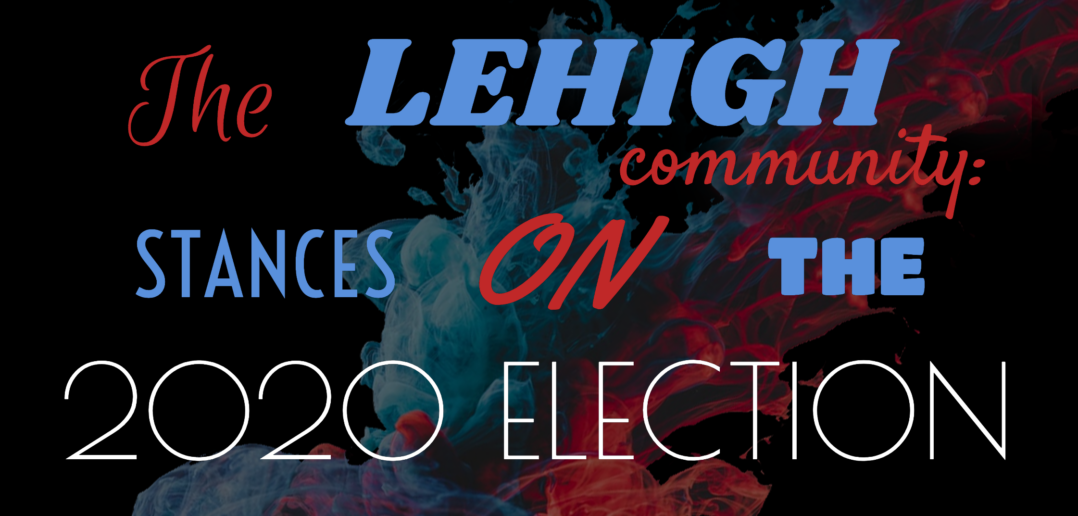Hundreds of members of the Lehigh community completed a Brown and White poll on both candidate preferences and issue stances ahead of the 2020 election.
The poll was made available to members of the Lehigh community via The Brown and White’s social media accounts, and to faculty department chairs and administration members through direct email. The survey was open from Aug. 28 through Sept. 16 and received a total of 505 responses.
Almost 83 percent of those who responded to the survey said they plan to vote for Joe Biden, the Democratic nominee, while 10.5 percent said they plan on voting for President Donald Trump. While 42.6 percent of respondents said they support their candidate “very strongly,” almost 3 in 10 said they are only voting for their candidate because they do not like the other options.
Of the individuals surveyed, about two-thirds identified as Democrats, 9.1 percent identified as Republicans and 20.6 percent said they were not affiliated with any party. In terms of ideology, about half of respondents identified as liberal, 30.7 percent identified as moderate, and 6.9 percent identified as conservative.
The Brown and White first analyzed responses by looking at the Lehigh community as a whole, and then again by looking at how responses differed by college, and at how responses differed by Lehigh affiliation. For purposes of the poll, “Lehigh affiliation” refers to whether the respondent was an undergraduate student, a graduate student, a faculty member, a staff member or an administrator.
For the breakdown of issue stance by college, the College of Health was excluded due to low response rates from that group. For the breakdown of issues stance by Lehigh affiliation, the administrator group was excluded for the same reason.
The poll questions were phrased based on popular wordings in existing political polls, and based on the advice of experts from Lehigh University’s Department of Journalism and Communication and the Lehigh University Pride Center.
Of the 505 respondents, 314 were undergraduate students and about two-thirds of respondents were under the age of 25.
Christopher Borick, professor of political science at Muhlenberg College and the director of the Muhlenberg College Institute of Public Opinion, said most national evidence indicates that this age group tends to be left-leaning ideologically and affiliates with the Democratic Party. He also said there is a large independent cohort within the 25-and-under age range as well.
He said one of the great partisan divides in American politics today is occurring between students pursuing college degrees or are university graduates and non-university graduates. Borick said the combination of that trend as well as other factors, like Lehigh’s Northeast location and the most popular home states among Lehigh students, helps explain the leftward lean of the data.
Brian Fife, professor and chair of Lehigh’s political science department, said the fact that almost 3 in 10 respondents are only voting for their candidate because they do not like the other options is not new or unique to the 2020 election. He said since at least 1860, when the United States has had two major parties contesting in the election, Americans have generally complained about their presidential choices.
“You can go back into the 19th Century, and you will hear the terms tweedledum and tweedledee, and that’s a reflection of people generally being disappointed in their major party choices,” Fife said.
Borick said in 2016, both candidates had unfavorability ratings that were historically high, resulting in an election where some voters were picking between two candidates they disliked.
“This year, if we see some of that same trend, it’s probably a part of this era of distrust in lots of things, including the candidates,” Borick said. “That’s often how campaigns are waged right now.”
In terms of turnout, 87.9 percent of respondents indicated they are “very likely” to vote and 93.1 percent said they are already registered.
Fife believes the sample is not necessarily representative of the entire Lehigh population given the higher number of student respondents. He also said middle-aged and older people are much more likely to vote than younger people. However, he hopes 2020 is different in that regard and that more young people vote.
Fife said low voter turnout among young people has always been a missed opportunity since the implementation of the 26th amendment. The amendment prohibited the federal government from using age to deny U.S. citizens above 18 years of age the right to vote.
“I would highlight the reality that some who are saying they are very likely to vote, will they actually vote?” Fife said.
Borick echoed that sentiment. He said the different age groups surveyed have different voter turnout rates and that when comparing faculty and undergraduates historically, there is likely a large difference in their voter turnout levels. About 16 percent of survey respondents were ages 40 to 59, and 10.9 percent were 25 to 39.
Borick said, however, the data found in the Brown and White poll aligns with what other empirical evidence is showing this year about increased engagement among younger voters. He believes college-aged students are engaged in the election process this year and said the findings from the poll are consistent with what broader evidence is showing about this election cycle.
Respondents were somewhat split on how to judge a candidate’s policy stances against his or her personality. Slightly more than 4 in 10 respondents said the candidate’s stance on issues impacts their voting decision while nearly half said a combination of the candidate’s stance on issues and his or her personality has the largest impact on who they choose to support.
Fife believes this phenomenon dates back to the advent of TV in American politics, which has ushered in an era of candidate-centered campaigns. He said historically in the United States, and in other democracies today, campaigns are largely party-centered.
“Our campaigns tend to focus more on style and personal characteristics,” Fife said. “I’m not saying people don’t care about the issues because that’s not true, but there’s more emphasis on what I would call non-substantive matters.”
Borick said our connection to candidates nowadays is through a personal lens. He said Americans analyze our comfort level with a candidate — the likeability factor — and we then form personal relationships with them.
On the issues, respondents were given a chance in the poll to share their stances on various hot-button political issues by rating on a scale of 1 to 5 how much they agree with a variety of statements. When asked about how well they believed the Trump administration has handled the COVID-19 pandemic, almost 7 in 10 respondents answered with 1, indicating that they are very unsatisfied.
On other issues, more than half the respondents indicated that they strongly believe the federal minimum wage should be raised from $7.25 an hour, 6 in 10 “definitely” believe marijuana should be legalized for medicinal and recreational use and almost 72 percent “definitely” are against the United States building a wall along the southern border.
More than 7 in 10 of respondents “definitely” believe there should be more restrictions on the current process for purchasing a gun. And about two-thirds say the government should be very involved in increasing environmental regulations to combat climate change. There is also clear two-thirds support for the Deferred Action for Childhood Arrivals program, or DACA.
A little over half of respondents strongly support requiring states to offer same-day voter registration, and 42.7 percent “definitely” believe that the Electoral College should be abolished altogether.
“When you look at largely college-aged populations, issues do matter, especially if neither candidate has a strong favorable image in (students’) minds,” Borick said. “Then you start turning to other aspects … where are their positions on salient issues like health care, economics, climate change, the pandemic response. Those things matter.”






Comment policy
Comments posted to The Brown and White website are reviewed by a moderator before being approved. Incendiary speech or harassing language, including comments targeted at individuals, may be deemed unacceptable and not published. Spam and other soliciting will also be declined.
The Brown and White also reserves the right to not publish entirely anonymous comments.
2 Comments
Good breakdown of data to look at various issues. Certainly demonstrates the old adage that students are both indoctrinated & liberal until such time that they become adults & responsible.
For example, 2/3rds supporting defunding Police is typical of irresponsible people not understanding the role of police as first responders. Once again this works until you need help & no one responds.
Lehigh has morphed into a bastion of unrealistic idealism that no longer prepares students for accepting responsibility for their own lives & blaming others for their failures.
Joe Biden knew. That’s the chief theme in the new Senate report on Hunter Biden’s laundry list of bad, possibly criminal behavior. The report notes that Hunter Biden was wired $3.5M from a Russian woman under mysterious circumstances.
Democratic presidential candidate Joe Biden has “not spoken accurately about his knowledge of his son’s involvement in Burisma” or the problem it caused for the Obama administration.
“While this Report is focused on Hunter Biden and James Biden and other family members of Joe Biden, not Joe Biden himself, it is also true that Joe Biden was revealed to have not spoken accurately about his knowledge of his son’s involvement in Burisma, the Ukrainian energy concern”
Biden said he didn’t know about it when the report shows that in fact, some bureaucrats were so concerned about Hunter Biden’s role that they had briefed him, that they had alerted the FBI.
Joe Biden has previously lied about his knowledge of his son’s dealings, but Obama era officials testified to the Senate committee investigating that they had personally briefed Biden on the matter and how big of a conflict of interest it was. They also, in at least one case, alerted the FBI about what was going on.